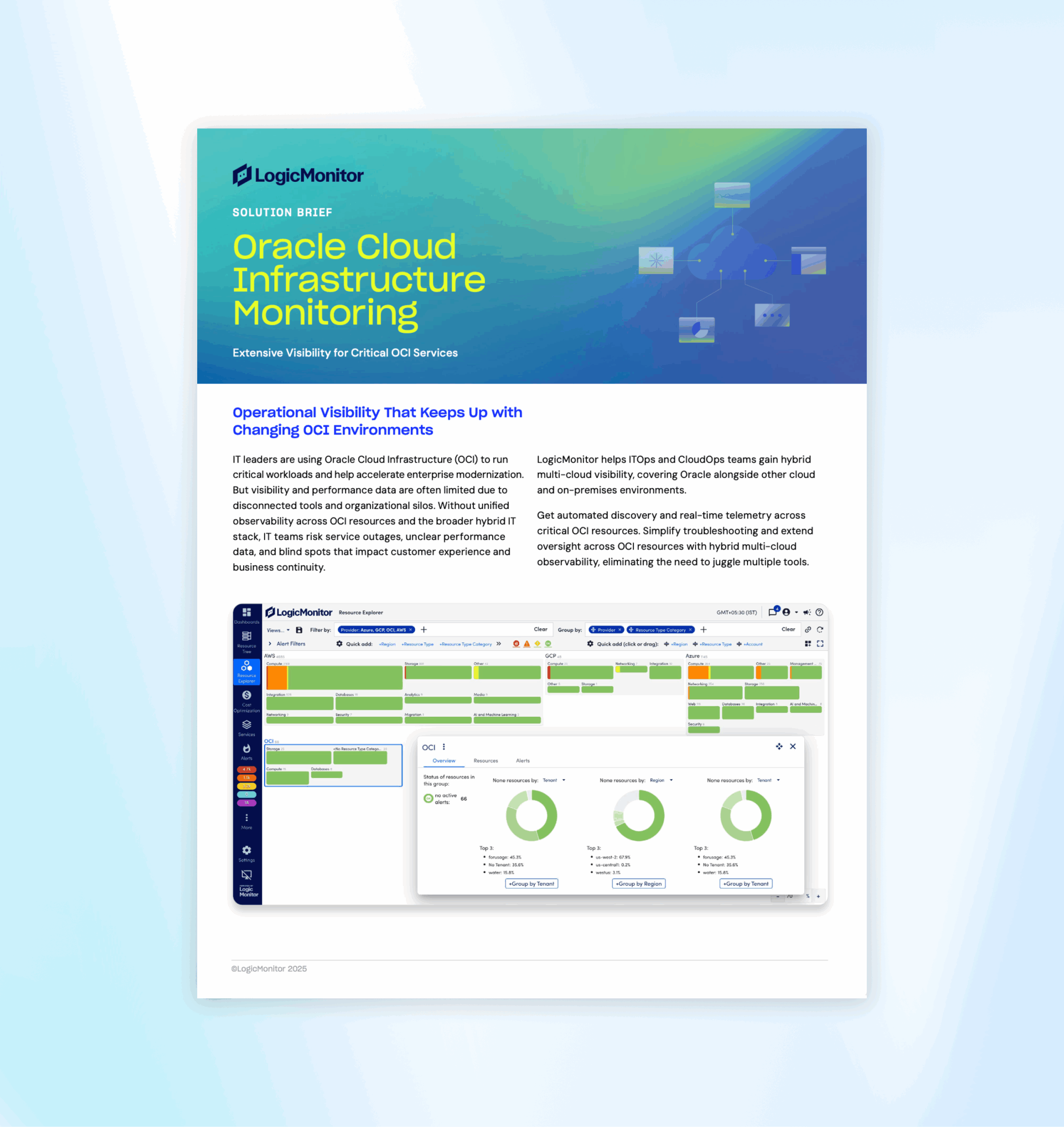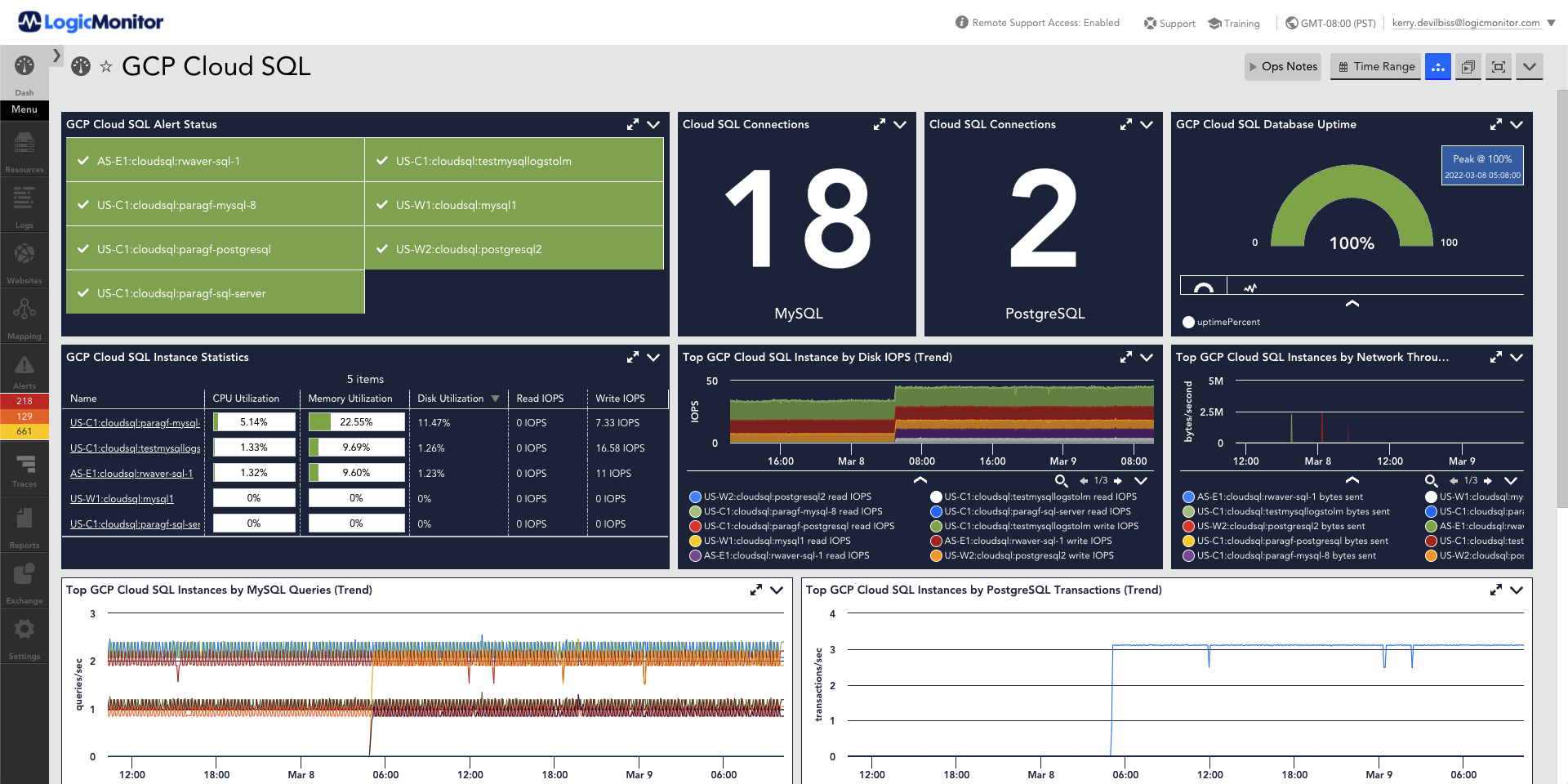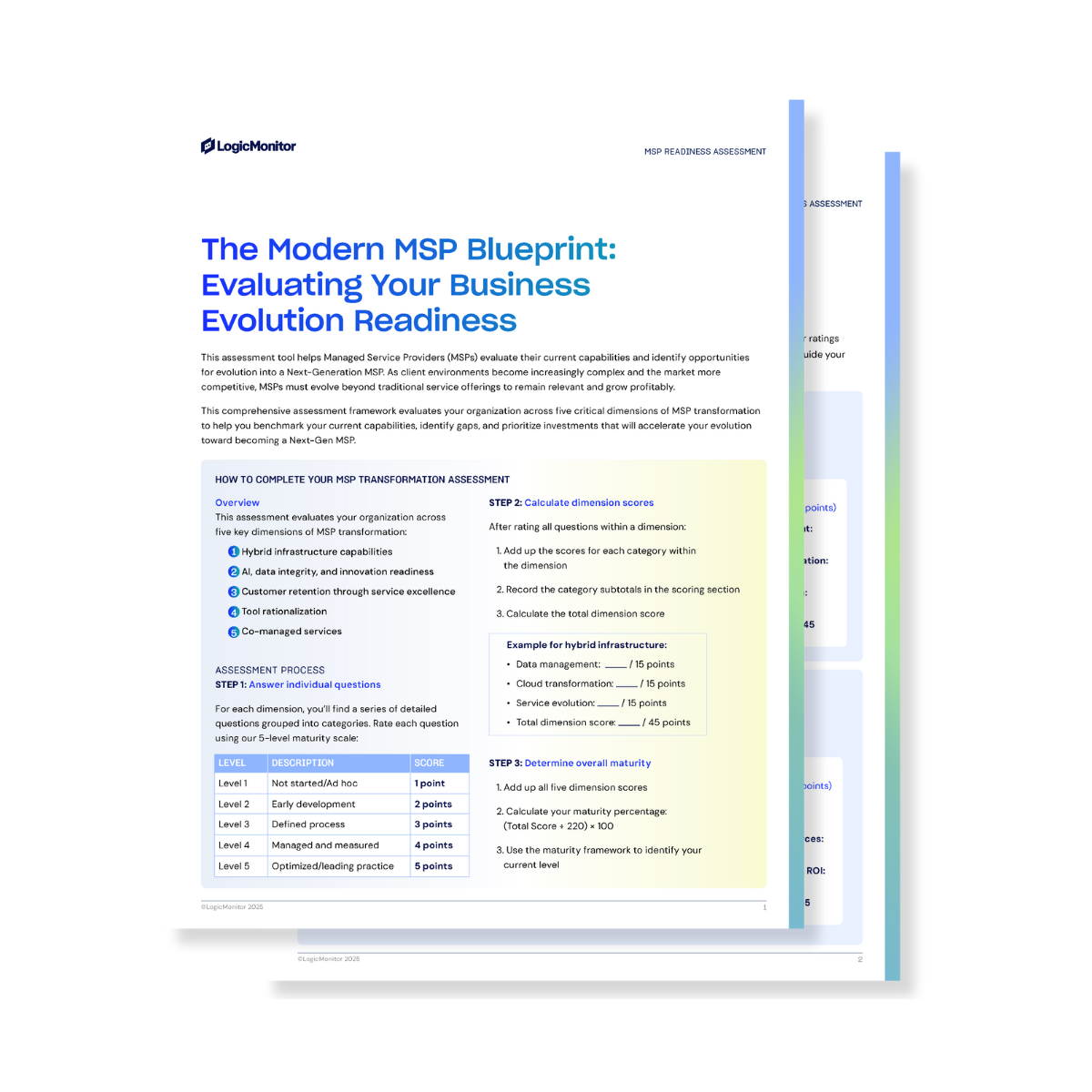Solution brief
Our MSP Evolution Assessment shows you exactly where you stand—and what moves will drive growth.
For over 25 years, nicos has provided flexible, reliable support to German manufacturers and global companies. But as nicos’ customer base grew in both technological needs and global footprint, the MSP found that it needed its own new, trusted partner to support scaling operations.
Before implementing LogicMonitor, nicos used a proprietary, on-premises legacy system that suffered from multi-hour delays in system updates and deployment of new monitoring endpoints. It also required extensive manual work each time a customer’s needs changed.
“In the past, it was quite simple. One router, one line connected to that router, and so on,” said Lemke. “But now we have cloud services and SD-WAN services where a device is connected to multiple lines. It’s a more diverse technical landscape.”
The company needed a solution that could:
To speed up its onboarding and improve observability, nicos leveraged a mix of existing LogicMonitor modules and built custom integrations using the LogicMonitor API and ServiceNow.
“Flexibility was important for us to have in a system. And we needed a software as a service (SaaS) solution where we aren’t operating the major parts of the infrastructure on our own,” Lemke said. “LogicMonitor helped us get custom projects up to speed a lot faster because several modules were already provided. We could set up monitoring for those individual service constructs very quickly.”
After deploying LogicMonitor and ServiceNow, nicos saw immediate improvements like:
“When we’re deploying new customers’ projects, we have anywhere from five to 300 sites to deploy,” said Lemke. “And LogicMonitor doesn’t require us to spend time doing everything by hand.”
Plus, the introduction of real-time monitoring empowers nicos customers to ensure their operations have the best possible uptime — further cementing nicos’ place as a leading MSP in the German market.
With their flexible LogicMonitor and ServiceNow integration in place, the nicos team is continually looking for new ways to improve how they collect and leverage data.
“We’re heavy users of the service insights layer because at nicos, we’ve always focused on delivering complete services and customised solutions — not just managing individual devices or lines,” said Lemke. “Our dedicated team continuously explores ways to integrate multiple sources of information and leverage AI to improve the efficiency of our monitoring systems.”

At LogicMonitor’s Senior Leadership Team Offsite in July, I sat down for a candid conversation with Kyle Hill, CTO of ANS Group. As a longtime LogicMonitor customer and leader of a 700+ person tech powerhouse, Kyle offered sharp insights into scaling infrastructure, unlocking AI-driven value, and what true partnership looks like in today’s MSP world.
Here’s an edited and condensed version of our conversation.
Kyle: Our goal is to democratize access to the world’s best digital services. We’re UK-based and serve over 2,000 customers across industries, such as the public sector, manufacturing, and retail. That means delivering consistently high service across a very diverse landscape. This requires us to be both technically sharp and deeply customer-centric. We want to simplify the complex, deliver outcomes fast, and always be predictable and reliable.
Kyle: Our customers look for a single partner that does it all. Every industry has its own needs. Public sector customers want governance and certainty. Retailers, for example, prioritise speed. One size doesn’t fit all, so we must deliver one platform that flexes for both. That’s where standardisation meets agility. We’ve built our internal systems and teams to be agile and resilient—whether that means navigating multi-cloud environments or delivering predictable performance at scale. Our customers require us to have that capability, those solutions, those skills on tap at any time.
Kyle: Hybrid wasn’t a buzzword for us—it was a business necessity. A lot of our customers have legacy applications, or data sovereignty requirements. A hybrid approach lets us meet them where they are and modernise at a pace that works for them.
Kyle: It all starts with trust. Many public sector clients need assurance that performance and compliance won’t be compromised. We deliver that confidence with visibility and automation, and LogicMonitor plays a central role in that.
Kyle: Around 2015, we were running fragmented tools from various other vendors. LogicMonitor offered full-stack visibility and scalability that we just couldn’t get anywhere else. That tipped the scale.
Kyle: Dramatically. You’re not “just a monitoring tool.” LogicMonitor underpins 30+ of our core services. It’s part of the fabric of our service delivery to our clients now. The uptime, performance and cost savings our customers see are all tied directly to what we’ve built with LogicMonitor. There’s a lot of new features and functionality coming from your product that we want to leverage, understand what it does, and how it can be part of our core business model. With our ongoing partnership, one challenge I put to our team was, “Give me a positive challenge where we can do more with LogicMonitor by embracing the innovation their platform is providing”, because we see the value and so do our customers.
Kyle: At the beginning of the year, we were averaging around 60,000 alerts a day—incredibly noisy! We worked with our teams to optimise and brought that down to under 10,000 a day. Case volumes dropped 26% in six months.. Engineers aren’t chasing noise. They’re focused, productive, and moving faster. When you apply that across 63,000+ Azure resources, the impact on the business is real and ultimately our customers benefit.
Kyle: Edwin AI is going to be a game-changer for us. It’s truly “always on” and we won’t have to worry about following the sun in different locations around the world. But what really excites us is the potential to go beyond correlation; using AI to surface patterns and provide recommendations that improve customer outcomes. That creates differentiation, especially around proactivity. It also opens the door to new customer opportunities and boosts customer satisfaction.
Kyle: There’s definitely excitement. But many don’t know where to start. Sometimes it’s a skills gap, sometimes it’s tooling or investment. Our opportunity is to bring solutions that already have AI built in, and to guide customers through the journey. That’s where we believe we can really stand out.
I come from the Microsoft ecosystem, and the engineering organization has a brilliantly-coined phrase that can be used when they’re challenged on when a feature will be completely finished. They’ll simply respond by saying: “In the fullness of time.” Technological capability is constantly evolving, as are the opportunities it provides for our customer base. We want our customers to know that we’re on this journey with them, and we’re going to help them get to the next step, always. We’re in this together.
Kyle: Thanks, Christina. The feeling is mutual. It’s been a fantastic journey, and we see LogicMonitor not just as a vendor—but a real partner in how we evolve.
Our MSP Evolution Assessment shows you exactly where you stand—and what moves will drive growth.


Solution brief



On-demand Webinar
MSPs face growing pressure to meet rising client expectations, control costs, and deliver stronger SLAs. As observability becomes foundational to IT operations, logs are evolving from backend data into a strategic asset.
Watch this webinar to discover how our latest innovation, Log Partitions, lets you manage retention by region, compliance needs, or customer groups. That means more control, cost efficiency, and the flexibility to tailor services without complexity.
See how LM Logs helps MSPs reduce MTTR, scale profitably, and deliver higher-value services that protect margins and strengthen client trust.

This session explores how to maximise the impact of LM Logs.



On-Demand Webinar
As global sustainability regulations evolve, managed service providers (MSPs) are uniquely positioned to guide clients through these changes and unlock new strategic value in the process.
The Corporate Sustainability Reporting Directive (CSRD) is now in effect, requiring enterprises to disclose risks and opportunities related to environmental and social issues in their annual reports. CSRD requirements apply for the first time to Financial Year 2024 reporting, published in 2025.
LogicMonitor Sustainability Monitoring is uniquely positioned to help support your clients and respond to this shift. Download our on demand webinar to hear more about the solution and how Electricity Maps has put it in action with their customers.
Gain visibility with LogicMonitor Sustainability Monitoring. Monitor carbon intensity, energy consumption, and ESG data across client environments in real time.

Sustainability has become a core client expectation – not just a “nice to have.” This session will help you:

Companies are embracing IT automation. As MSPs look to scale operations in 2022 and beyond, there are a number of technologies and methods available to improve efficiency and deliver a more seamless experience for end customers. Automation is one way to increase delivery velocity and onboard more customers with fewer engineering resources.
Download this whitepaper for actionable tips on how to use automated processes to save time, do more, continue to delight your end customers.

Sometimes the biggest transformations begin with what sounds like the worst possible news. One day, this Fortune 500 technology company’s observability platform was running smoothly. The next, they learned their critical monitoring solution would be discontinued as part of a corporate buyout.
For a leading global IT vendor in data infrastructure serving customers across storage, cloud, and managed services, this was a potential catastrophe. Two of their most critical ITOps teams suddenly faced the prospect of operating blind, with no visibility into the systems that kept customer environments running.
The clock was ticking. They had weeks to find a replacement solution and deploy it before their existing platform went dark.
Within three weeks, they had deployed LogicMonitor Envision and Edwin AI. Within 72 hours of activation, they had eliminated 93% of their incident volume—turning what could have been an operational disaster into a dramatic improvement over their previous state.
Before the crisis forced their hand, this tech giant was already drowning in operational noise. Their engineering teams were trapped in a vicious cycle that will sound familiar to anyone managing complex IT environments at scale. They had thousands of incidents generated a day, with engineers spending their mornings sifting through a digital avalanche of duplicates, false positives, and context-free notifications.
Fragmentation was killing their effectiveness. Internal systems generated one stream of alerts, customer-facing environments produced another, and the complete lack of correlation meant engineers were constantly switching contexts as they tried to piece together the bigger picture. A single underlying issue might trigger dozens of separate alerts across different systems, each treated as an independent incident requiring individual investigation.
“We were overwhelmed,” admitted one senior team member. “Too many alerts, not enough signal. We needed help focusing on what actually mattered.”
The distinction between monitoring and observability had never been more critical. Their existing setup could tell them when something crossed a threshold, but it couldn’t explain why systems were failing or how incidents connected across their hybrid infrastructure. When problems cascaded through their environment, engineers burned precious time assembling clues from disparate sources while customer-facing services remained compromised.
Even worse, this noise was actively undermining their ability to deliver on their commitments. SLAs were slipping as real problems got buried under false alarms. Service continuity suffered when critical issues went unnoticed in the flood of notifications. Customer experience degraded as engineers remained trapped in reactive mode.
Ironically, in an age of unprecedented visibility into system performance, they were essentially operating blind.
With their existing platform’s expiration date looming and operational chaos mounting, the technology leader faced an impossible timeline. They needed to evaluate, select, and deploy a replacement solution in weeks—all while maintaining service levels for critical customer environments.
The evaluation process revealed a harsh reality. Most enterprise monitoring solutions required lengthy implementations that could stretch for quarters. Complex integrations, extensive customization, and drawn-out deployment cycles were luxuries they simply couldn’t afford. They needed something that could deliver immediate value without the traditional overhead of enterprise software rollouts.
LogicMonitor Envision and Edwin AI emerged as the clear choice, but not just because of their technical capabilities. The combination offered something their crisis demanded: speed without compromise. LogicMonitor’s hybrid observability platform could provide the comprehensive visibility they needed across their complex infrastructure, while Edwin AI promised to solve their most pressing problem—the overwhelming noise that was paralyzing their operations.
What sealed the decision was Edwin AI’s precision approach to incident response. Unlike traditional rule-based systems that simply filtered alerts, Edwin AI could actually understand the relationships between incidents, automatically correlate related events, and accelerate root cause analysis.
The scalability factor proved equally crucial. Their organization needed to support two distinct but interconnected teams: internal engineering focused on infrastructure operations and managed services responsible for customer-facing environments. Most solutions would have required separate deployments with limited coordination between them. LogicMonitor and Edwin AI offered the flexibility to create synchronized deployments that could operate independently while sharing intelligence and insights.
Within days of their initial evaluation, it became clear that this combination could help them regain control of their operations while actually improving their capabilities beyond what they’d lost in the acquisition.
What happened after deployment defied even their most optimistic expectations. Within 72 hours of Edwin AI going live, the same teams that had been drowning were witnessing a complete transformation of their incident management reality.
The numbers were staggering. Edwin AI automatically reduced 93% of incidents flowing into ServiceNow based on external resolution signals and intelligent correlation. The digital avalanche that had consumed their days vanished, replaced by a manageable stream of genuinely critical issues that actually required human intervention.
But the real breakthrough was in speed and precision. Edwin AI cleared 1,300 false positives in under 10 minutes, eliminating hours of investigative work that would have pulled engineers away from real problems. Another 1,650 incidents were resolved within a single hour, turning what used to be day-long troubleshooting marathons into quick, focused responses.
The transformation extended far beyond the numbers. Engineers who had started each day bracing for an overwhelming barrage of notifications were suddenly able to focus on strategic work. SLA adherence improved dramatically as real issues were no longer buried under false alarms. Customer experience benefited as problems were identified and resolved before they could cascade into service disruptions.
“We’ve seen a dramatic reduction in alert noise and faster resolution times,” said one engineering lead. “Edwin AI helped our teams stay focused, maintain SLAs, and deliver a better experience to both internal and external users.”
Perhaps most remarkably, this wasn’t the result of months of fine-tuning and optimization. This was day-one performance from an AI system that understood their environment well enough to immediately distinguish between noise and signal—solving in hours what had taken their previous approach years to create.
For the managed services team responsible for maintaining customer-facing environments, the deployment timeline was ambitious. Any disruption to their monitoring capabilities could cascade into service outages affecting dozens of enterprise customers. They needed a migration that was both lightning-fast and completely seamless.
Traditional enterprise software deployments are measured in quarters. Complex integrations, extensive testing phases, and gradual rollouts are standard practice for a reason: they minimize risk. But this team didn’t have the luxury of a cautious approach. Their existing platform’s shutdown date was fixed, and customers couldn’t experience even momentary gaps in service monitoring.
What followed was a masterclass in streamlined implementation. LogicMonitor and Edwin AI were deployed, configured, and activated in just three weeks—a timeline that would be aggressive for a greenfield deployment, let alone a critical system migration under pressure. The deployment required minimal configuration overhead, with Edwin AI’s intelligent capabilities adapting to their environment rather than demanding extensive customization.
Most importantly, the transition happened invisibly to their customers. Service monitoring continued uninterrupted throughout the migration, with no gaps in coverage or temporary blind spots that could have put customer environments at risk. The managed services team maintained their SLA commitments while simultaneously overhauling their entire observability infrastructure.
“We didn’t have time for a long rollout,” explained one team lead. “LogicMonitor and Edwin AI were up and running fast with zero disruption to our customers.”
The speed of deployment proved that modern AI-driven solutions could deliver enterprise-grade reliability without enterprise-typical implementation overhead. In an era where business moves faster than traditional IT deployment cycles, this kind of rapid, low-risk implementation capability represents a fundamental shift in how organizations can adopt new technology.
The dramatic success of their initial deployment represented a fundamental shift in how this company approaches IT operations. Having tasted the power of AI-driven incident management, they’re now positioning themselves at the forefront of a broader transformation in enterprise ITOps.
The immediate wins were impressive, but the real opportunity lies in what comes next. With Edwin AI proving its value in their most critical environments, the organization is now expanding their AI strategy across multiple dimensions. The reactive approach that had defined their operations for years is giving way to something far more sophisticated: truly predictive operations.
Their roadmap reveals the full potential of AI-powered ITOps. Generative and agentic capabilities are being activated to provide auto-summarization of complex incidents, accelerated root cause analysis that can trace problems across interconnected systems, and predictive insights that identify potential issues before they manifest as outages. These are improvements that represent a complete reimagining of how IT operations can function.
The expansion is equally ambitious. Having proven the concept with two critical teams, they’re now scaling agentic AI across additional internal and customer-facing environments. Each new deployment builds on the intelligence gathered from previous implementations, creating a network effect where the AI becomes more effective as it monitors more systems and learns from more incidents.
But perhaps the most transformative element is their shift from reactive to preventive operations. Using pattern recognition and historical data analysis, Edwin AI is helping them anticipate disruptions before they impact operations. Instead of waiting for alerts to fire, they’re identifying the conditions that typically precede problems and taking action while issues are still manageable.
“Our goal is to anticipate challenges before they happen,” explained one senior leader. “Edwin AI is a key partner in making that vision a reality.”
This evolution from crisis management to strategic advantage illustrates a broader truth about AI in enterprise operations: the organizations that will thrive aren’t just those that deploy AI to solve today’s problems, but those that leverage it to prevent tomorrow’s challenges entirely.
We’ve reached an inflection point where AI has moved from experimental technology to operational necessity. Their story is a preview of how modern ITOps will function in an increasingly complex digital landscape.
And the broader implications are impossible to ignore. Enterprise IT leaders everywhere are grappling with the same fundamental challenges that nearly overwhelmed this organization: hybrid environments that span multiple clouds and on-premises systems, shrinking IT budgets that demand more efficiency from smaller teams, and user expectations that continue to expand while tolerance for downtime approaches zero.
Traditional approaches to IT operations simply can’t scale to meet these demands. The manual processes, reactive workflows, and human-intensive troubleshooting that defined IT operations for decades are breaking down under the weight of modern complexity. This company’s pre-AI state represents the inevitable outcome of trying to manage 21st-century infrastructure with 20th-century methods.
Edwin AI and similar intelligent automation platforms represent a fundamental evolution in how IT operations function. Engineers freed from the constant noise of false alarms can focus on strategic initiatives, complex problem-solving, and the kind of high-value work that actually moves organizations forward. The result is operations teams that can do more with less while maintaining higher service levels than ever before.
An operations team at one of the Asia-Pacific’s largest managed service providers (MSPs) was drowning in their own success. Years of investment in monitoring tools and automation had created comprehensive visibility—and comprehensive chaos. Engineers opened dashboards each morning to find thousands of alerts waiting, with critical incidents buried somewhere inside.
The scale of the problem was overwhelming their capacity to respond effectively. As the business grew, meeting SLAs became increasingly difficult, and service quality suffered under the weight of alert fatigue.
The MSP needed a fundamental change in approach. That change came in the form of Edwin AI, an AI agent for ITOps. Implementing this AI-powered incident management product achieved measurable results within weeks. Alert noise dropped by 78%, incident volumes decreased dramatically, and the team shifted from reactive firefighting to strategic problem-solving.
Here’s how they transformed their IT operations.
The MSP implemented Edwin AI, LogicMonitor’s AI agent for ITOps, to process alert streams from their existing observability infrastructure. Edwin AI operates as an intelligence layer between their current tools, ingesting raw alerts from across the technology stack, identifying patterns, eliminating duplicate issues, and surfacing incidents that require human attention.
Instead of engineers manually connecting related events across different systems, Edwin AI performs correlation work automatically and routes consolidated incidents directly into ServiceNow.
The implementation created immediate operational changes:
Engineers now receive incidents with the context needed to begin troubleshooting immediately. Edwin AI eliminated the need to hunt through multiple systems to understand system failures. By converting fragmented alert streams into structured incident workflows, it allows technical teams to apply their expertise to resolution rather than information gathering.
Edwin AI delivered measurable improvements within weeks of implementation, including:
These improvements freed up significant engineering time. The team can now concentrate on high-impact incidents and resolve them more efficiently. With fewer context switches between low-priority alerts, engineers gained capacity for proactive system improvements.
The operational transformation benefited both customers and staff. Service quality improved while engineer burnout decreased. The MSP gained a clearer path toward operational excellence through intelligent incident management.
Edwin AI restructured the MSP’s entire incident management process by converting raw alerts into comprehensive, contextual incidents. Engineers receive complete information packages rather than fragmented data requiring manual assembly.
Each incident now includes:
Engineers work with complete narratives that explain what happened, the business impact, and recommended responses.
ServiceNow evolved from a ticket repository into a comprehensive source of truth. Edwin AI feeds deduplicated and correlated events into the ITSM system, ensuring each ticket contains full context rather than isolated alert fragments.
According to the operations lead: “Edwin AI gives us clarity on what’s actually meaningful. We see the complete picture instead of puzzle pieces.”
This workflow transformation changed how the team approaches incident management, shifting from information gathering to solution implementation.
The MSP’s success with Edwin AI has opened the door to even more ambitious operational improvements. With alert noise under control and workflows streamlined, they’re now exploring how AI can move beyond correlation to autonomous decision-making.
Their roadmap includes agentic AIOps capabilities that will surface instant, context-aware answers pulled from telemetry data, runbooks, and historical incidents. Root cause analysis summaries will be delivered directly in collaboration tools like Slack and Teams, accelerating team decision-making. And Edwin’s GenAI Agent will also provide runbook-based recommendations that combine Edwin’s pattern recognition with the MSP’s own operational expertise.
The long-term vision extends beyond faster incident response to fundamentally different operations. Instead of engineers reacting to system events, AI will handle routine remediation while humans focus on complex problem-solving and strategic improvements. This evolution from reactive to proactive to autonomous operations represents the next phase in IT operations maturity.
Their operations lead frames it simply: “We’ve proven AI can sort the signals from the noise. Now we’re working toward AI that can act on those signals automatically.”
AIOps environments have reached a complexity threshold that challenges traditional management approaches. Hybrid architectures, escalating customer demands, and continuous service expectations create operational loads that strain human capacity.
This MSP’s transformation demonstrates a replicable approach: intelligent alert filtering eliminates noise before it reaches human operators, automated correlation and deduplication prevent redundant work, and engineers gain capacity for strategic initiatives that drive business value.
The operational model shift from reactive alert processing to proactive system management addresses the fundamental scalability challenge facing managed service providers today.
According to their operations lead: “Modern ITOps generates a storm of signals no human team can sift alone. AI lets our people do more with less and still raise the bar on service. It turns complexity into a competitive advantage.”
MSPs operating without AI-powered incident management face mounting pressure as alert volumes continue growing while human capacity remains fixed. Organizations implementing intelligent automation now establish operational advantages that become increasingly valuable over time.
For MSPs evaluating their incident management approach, this transformation offers a clear example of how AI can turn operational complexity from a burden into a competitive advantage.
As one of Australia’s leading managed service providers, Tecala is trusted by a wide range of organizations to deliver IT services that drive performance, security, and innovation. But their ability to scale was hitting a wall.
Manual workloads. Infrastructure bottlenecks. Slow onboarding that delayed client value. These legacy challenges were getting in the way of Tecala’s growth and service excellence.
A fast, future-ready transformation Tecala knew they needed to modernize—fast. Their teams were stretched, and onboarding new customers was taking far too long. That’s when they turned to LogicMonitor.
With LM Envision, Tecala transformed their monitoring strategy in just 90 days.
Here’s how LogicMonitor helped:
Ben Leggo
COO, Tecala
Managed service providers face constant pressure to scale efficiently, deliver faster results, and protect service quality across a growing portfolio. Tecala’s story proves that the right observability platform can unlock all three—while setting the stage for AI-powered operations.
With LogicMonitor, MSPs can:
Faster time-to-value, greater efficiency, and more strategic focus—for Tecala and the customers they serve.


Assessment
Break through the MSP ceiling with a self-assessment that actually moves the needle.
Your clients’ tech environments grow more complex every quarter. Meanwhile, your competitors are scrambling to reinvent themselves. Where do you fit in? Our MSP Evolution Assessment cuts through the noise to show you exactly where you stand—and what moves will actually drive growth.
Our assessment examines your business across five critical dimensions:
Once you’re done, turn your insights into real transformation. Contact our MSP experts to help you:

The assessment is just the start. Get the whitepaper to see how leading MSPs are turning strategy into action (and growth into margin).
